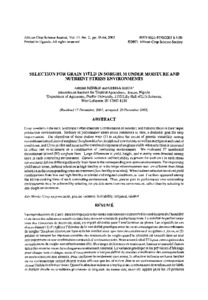| dc.contributor.author | Bigirimana, S. |
| dc.contributor.author | Barumbanze, P. |
| dc.contributor.author | Obonyo, R. |
| dc.contributor.author | Legg, J.P. |
| dc.date.accessioned | 2019-12-04T11:23:55Z |
| dc.date.available | 2019-12-04T11:23:55Z |
| dc.date.issued | 2004-04 |
| dc.identifier.citation | Bigirimana, S., Barumbanze, P., Obonyo, R. & Legg, J.P. (2004). First evidence for the spread of East African cassava mosaic virus–Uganda (EACMV‐UG) and the pandemic of severe cassava mosaic disease to Burundi. Plant Pathology, 53(2), 231-231. |
| dc.identifier.issn | 0032-0862 |
| dc.identifier.uri | https://hdl.handle.net/20.500.12478/4211 |
| dc.description.abstract | Cassava mosaic disease (CMD) is the most important constraint to cassava (Manihot esculenta) production in Africa. Since the 1990s, the importance of the disease has been greatly increased by the spread through East and Central Africa of a pandemic of unusually severe CMD (Legg, 1999), associated with the recombinant begomovirus, East African cassava mosaic virus– Uganda (EACMV-UG) (Zhou et al., 1997). Following reports of the spread of EACMV-UG to Rwanda (Legg et al., 2001), it became apparent that Burundi, to the south, was also threatened. A survey of cassava plantings in Burundi was therefore conducted in May/June 2003 to assess the status of CMD and to identify begomoviruses present.
Fifty-three fields were sampled in 10 of the country's 16 regions and CMD-diseased leaf samples collected in each field for virus diagnosis. Assessments were made of CMD incidence, severity (using the standard 1–5 scale), infection type (either cutting or whitefly borne) and abundance of the whitefly vector, Bemisia tabaci. Viruses were diagnosed from leaf samples using both specific primer PCR (Zhou et al., 1997) and restriction digestion with EcoRV and MluI of near full-length DNA-A fragments amplified using universal begomovirus primers (Briddon & Markham, 1994).
EACMV-UG, ACMV, EACMV and mixed ACMV + EACMV-UG infections were identified from 17, 34, one and three sites, respectively. EACMV-UG occurred at all sites in the north-eastern regions of Muyinga and Kirundo, was present at some sites in northern Gitega, Ngozi, Karuzi, Kayanza, Ruyigi and northern Rutana, but was not recorded from southern Gitega, southern Rutana, Muramvya or Bujumbura. The EACMV-UG-affected regions of Muyinga and Kirundo were distinct from the others in having higher CMD incidence (79 vs. 42%), a greater proportion of whitefly-borne to cutting-borne infection (1·9 vs. 0·6), more severe symptoms (4·17 vs. 3·26) and a greater abundance of B. tabaci (4·9 vs. 1·0). This data set provides clear evidence for the rapid spread of severe EACMV-UG-associated CMD in the north-eastern regions of Kirundo and Muyinga. The occurrence of EACMV-UG at sites in northern, central and eastern Burundi also suggests that similar changes in CMD epidemiology are likely to occur here in the near future. These results represent the first report of the expansion of the African CMD pandemic into Burundi. |
| dc.description.sponsorship | United States Agency for International Development |
| dc.language.iso | en |
| dc.subject | Cassava |
| dc.subject | African Cassava Mosaic Virus |
| dc.subject | Manihot Esculenta |
| dc.title | First evidence for the spread of East African cassava mosaic virus Uganda (EACMVUG) and the pandemic of severe cassava mosaic disease to Burundi |
| dc.type | Journal Article |
| dc.type | Journal Article |
| dc.description.version | Peer Review |
| cg.contributor.crp | Roots, Tubers and Bananas |
| cg.contributor.affiliation | Institut des Sciences Agronomiques du Burundi |
| cg.contributor.affiliation | International Institute of Tropical Agriculture |
| cg.coverage.region | Africa |
| cg.coverage.region | West Africa |
| cg.coverage.country | Burundi |
| cg.coverage.country | Uganda |
| cg.isijournal | ISI Journal |
| cg.authorship.types | CGIAR and developing country institute |
| cg.iitasubject | Cassava |
| cg.iitasubject | Plant Diseases |
| cg.accessibilitystatus | Limited Access |
| local.dspaceid | 99777 |
| cg.identifier.doi | https://doi.org/10.1111/j.0032-0862.2004.00971.x |

